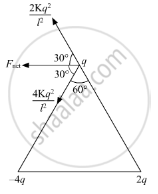Advertisements
Advertisements
प्रश्न
Three-point charges q, – 4q and 2q are placed at the vertices of an equilateral triangle ABC of side 'l' as shown in the figure. Obtain the expression for the magnitude of the resultant electric force acting on the charge q

(b) Find out the amount of the work done to separate the charges at infinite distance.
उत्तर

\[ = \frac{3\sqrt{3}K q^2}{l^2}\]
(b) PEinitial =
\[- \frac{8K q^2}{l} - \frac{4K q^2}{l} + \frac{2K q^2}{l}\]
\[ = - \frac{10K q^2}{l}\]
PEfinal = 0
Workdone = PEfinal - PEinitial =
APPEARS IN
संबंधित प्रश्न
Two charged particles are placed 1.0 cm apart. What is the minimum possible magnitude of the electric force acting on each charge?
Find the ratio of the electrical and gravitational forces between two protons.
A hydrogen atom contains one proton and one electron. It may be assumed that the electron revolves in a circle of radius 0.53 angstrom (1 angstrom = 10−10 m and is abbreviated as Å ) with the proton at the centre. The hydrogen atom is said to be in the ground state in this case. Find the magnitude of the electric force between the proton and the electron of a hydrogen atom in its ground state.
Two charged particles with charge 2.0 × 10−8 C each are joined by an insulating string of length 1 m and the system is kept on a smooth horizontal table. Find the tension in the string.
A particle A with a charge of 2.0 × 10−6 C and a mass of 100 g is placed at the bottom of a smooth inclined plane of inclination 30°. Where should another particle B, with the same charge and mass, be placed on the incline so that it may remain in equilibrium?
Two particles A and B, each carrying a charge Q, are held fixed with a separation dbetween them. A particle C of mass m and charge q is kept at the middle point of the line AB. Assuming x<<d, show that this force is proportional to x.
Write a short note on superposition principle.
Explain in detail Coulomb’s law and its various aspects.
Identify the wrong statement in the following.
Coulomb's law correctly describes the electric force that ______
Which of the following statements about nuclear forces is not true?
